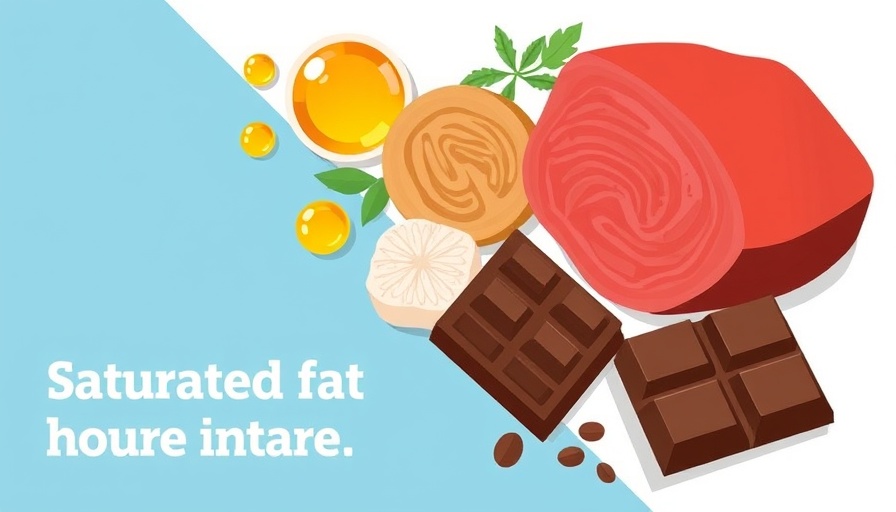
Understanding Saturated Fat: The Essential Facts
Saturated fat has long been a controversial topic in the world of nutrition and health. While essential fats support various bodily functions, numerous studies link high saturated fat consumption to increased risk of heart disease. Even though the body does require some amount of saturated fats for hormone production and cellular function, striking the right balance is crucial. Recognizing what foods contain saturated fats and understanding how they fit into a healthy diet can empower individuals to take charge of their health.
In '9 Tips for Limiting Saturated Fat', the discussion dives into practical strategies for healthier dietary choices, exploring key insights that sparked deeper analysis on our end.
Why Women and Men Need to Be Mindful of Saturated Fats
Between the ages of 30 to 60, women and men often experience metabolic shifts and lifestyle changes. Heart disease remains one of the leading health concerns in this demographic. Being aware of the amount of saturated fat consumed can help manage weight and reduce the risk of chronic diseases. For individuals earning $100,000+ annually, prioritizing their health is essential, not just for personal well-being but also for maintaining productivity in a high-pressure work environment.
9 Practical Tips for Limiting Saturated Fat Intake
Achieving a balanced lifestyle doesn’t mean giving up flavor or satisfaction in meals. Here are nine actionable tips aimed at reducing saturated fat intake:
- Choose Lean Proteins: Opt for chicken, turkey, and fish instead of beef or pork, which are generally higher in saturated fats.
- Go Plant-Based: Incorporate more legumes, nuts, and whole grains into your diet. These provide not only essential proteins but healthier fats.
- Switch Cooking Oils: Utilize oils such as olive oil or canola oil rather than butter, which is known for its saturated fat content.
- Mind the Dairy: Opt for low-fat or fat-free dairy options instead of full-fat choices to cut down on saturated fat without sacrificing calcium intake.
- Read Labels: Familiarize yourself with nutrition labels and choose products with lower saturated fat percentages.
- Get Creative with Cooking: Explore new cooking techniques like grilling, steaming, and baking instead of frying, which can add unnecessary fats to meals.
- Enjoy More Fruits and Vegetables: A diet rich in fruits and vegetables can naturally lower saturated fat intake while providing essential nutrients.
- Limit Processed Foods: Many snack foods and processed meals are high in saturated fats. Opt for whole foods whenever possible.
- Practice Portion Control: Even healthy fats can contribute to high saturated fat intake if consumed in excess. Balance and moderation are key.
The Emotional and Social Aspects of Dieting
Transitioning to a diet lower in saturated fat may also involve emotional challenges. Food is often tied to social events and cultural practices, meaning lifestyle changes can provoke a sense of loss or even isolation. Encouraging individuals within partnerships or family units to undertake this journey together can smoothen the transition.
Future Perspectives: Sustainable Eating Trends
The push towards healthier eating patterns represents not only a personal health phenomenon but reflects larger societal trends. As awareness of nutrition expands and sustainable eating becomes more mainstream, individuals are inclined toward making informed dietary changes. Going plant-based has gained traction among younger generations, a trend that could redefine consumption patterns in upcoming years.
Common Misconceptions About Saturated Fats
Many people believe that all fats are bad, which creates a misunderstanding regarding healthier varieties. It’s important to recognize that not all saturated fats carry the same risks. For instance, some sources like coconut oil have both supporters and detractors in the health community. A nuanced understanding enables better choices over simple avoidance.
Conscious eating is an empowering step toward wellness. The insights and approaches provided through these tips empower individuals to make informed decisions about their diets. To learn more about maintaining a balanced health profile, consider participating in community health events or workshops that focus on nutrition. Remember: positive changes start with small, manageable steps!
 Add Row
Add Row  Add
Add 




Write A Comment